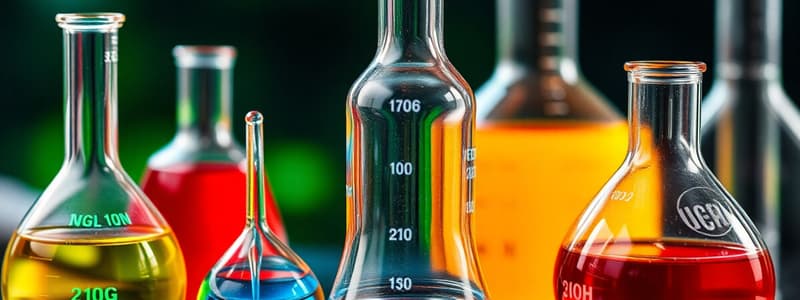Podcast
Questions and Answers
What is a fundamental difference between chemical changes and physical changes?
What is a fundamental difference between chemical changes and physical changes?
- Chemical changes involve a change in temperature, while physical changes do not.
- Chemical changes result in the formation of new substances, while physical changes do not. (correct)
- Chemical changes occur only at high pressures, while physical changes can occur at any pressure.
- Chemical changes are always reversible, whereas physical changes are not.
Which of the following statements is true regarding the Law of Conservation of Mass?
Which of the following statements is true regarding the Law of Conservation of Mass?
- Mass must be accounted for only in physical changes.
- Mass remains constant and is conserved during all chemical reactions. (correct)
- Mass can be created during a chemical reaction under specific conditions.
- Mass is destroyed in chemical reactions where gas is produced.
What type of reaction is represented by the equation Fe + S → FeS?
What type of reaction is represented by the equation Fe + S → FeS?
- Decomposition reaction
- Combustion reaction
- Synthesis reaction (correct)
- Single replacement reaction
Which scientist is known for introducing precise measurement techniques to the study of chemical reactions?
Which scientist is known for introducing precise measurement techniques to the study of chemical reactions?
Which statement correctly describes a physical change?
Which statement correctly describes a physical change?
Flashcards
Chemical Change
Chemical Change
A chemical change creates new substances with different properties, involving breaking and forming bonds.
Physical Change
Physical Change
A physical change alters the physical state or appearance of a substance without changing its chemical makeup. It doesn't create new substances.
Law of Conservation of Mass
Law of Conservation of Mass
The mass of reactants equals the mass of products in a chemical reaction.
Synthesis Reaction
Synthesis Reaction
Signup and view all the flashcards
Balanced Chemical Equation
Balanced Chemical Equation
Signup and view all the flashcards
Study Notes
Chemical Reactions - Grade 10
- Chemical Reactions: Transformations of substances, involving reactants forming new products. Reactants are the starting materials.
- Chemical Reactions in Everyday Life: Crucial for many processes, including burning.
- Distinguishing Chemical & Physical Changes: Chemical changes create new substances; physical changes do not. Examples include ice melting (physical) and a chemical reaction like sodium reacting with water. Chemical changes involve breaking and forming bonds; physical changes often involve changes in state.
- Historical Development of Chemical Reactions: Chemical reaction studies began over 250 years ago. Antoine Lavoisier pioneered precise measurements; John Dalton's atomic theory explained their occurrence. Modern chemistry combines experimentation and theory.
- Basic Concepts of Chemical Reactions: Synthesis reactions involve simpler substances combining to form more complex ones. The Law of Conservation of Mass states that mass is conserved in reactions. Equations should reflect this law, ensuring the same number of atoms of each element is on both sides.
Formative Assessment
- Chemical vs. Physical Changes: Students should differentiate between them.
- Conservation of Mass: Students should illustrate this concept with an example.
- Lavoisier's Impact: Students should explain Lavoisier's contribution to chemistry.
- Synthesis Reactions: Students should describe what happens in a synthesis reaction.
Studying That Suits You
Use AI to generate personalized quizzes and flashcards to suit your learning preferences.




